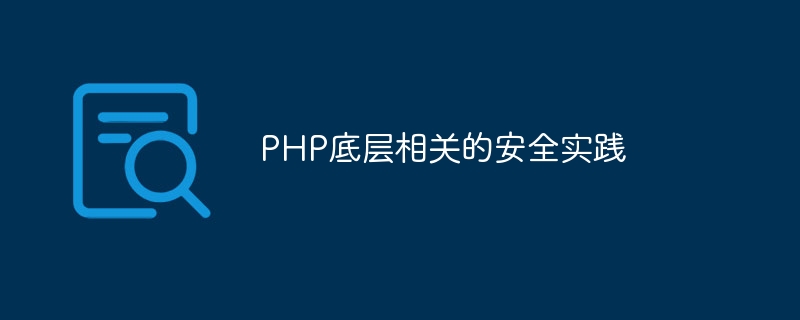Home >Backend Development >PHP Tutorial >Security practices related to the bottom layer of PHP
Security practices related to the bottom layer of PHP
- 王林Original
- 2023-11-08 17:52:431072browse

Security practices related to the bottom layer of PHP require specific code examples
With the rapid development of web applications, network security threats are also increasing. As one of the widely used backend programming languages, PHP applications are also exposed to various potential security risks. To be able to protect PHP applications from malicious attacks, developers need to understand some basic underlying security practices and take appropriate protective measures in their code.
The following will introduce several security practices related to the bottom layer of PHP and provide specific code examples.
- Input Validation and Filtering
User input is one of the most common security vulnerabilities. Attackers can leverage unvalidated and unsanitized user input to inject malicious code or perform unauthorized actions. In order to prevent this attack,
we need to validate and filter the data entered by the user to ensure that it conforms to the expected data type and format.
The following is a sample code that validates and filters user input:
// 验证和过滤用户提交的邮箱地址
function validateEmail($email){
if (filter_var($email, FILTER_VALIDATE_EMAIL)) {
// 邮箱地址格式正确
return true;
} else {
// 邮箱地址格式不正确
return false;
}
}
// 使用示例
$email = $_POST['email'];
if(validateEmail($email)){
// 邮箱格式正确,可以继续处理
} else {
// 邮箱格式不正确,给用户提示错误信息
}- Reduce SQL injection vulnerabilities
SQL injection refers to an attacker passing in SQL Malicious code is inserted into queries or commands to bypass data validation and filtering mechanisms and obtain, modify or delete sensitive data. To prevent SQL injection attacks,
we should use parameterized queries or prepared statements to build SQL statements instead of directly splicing user-entered data.
The following is a sample code using prepared statements:
// 连接数据库
$servername = "localhost";
$username = "username";
$password = "password";
$dbname = "database";
$conn = new mysqli($servername, $username, $password, $dbname);
// 检查连接是否成功
if ($conn->connect_error) {
die("连接失败: " . $conn->connect_error);
}
// 使用预处理语句来查询数据库
$stmt = $conn->prepare("SELECT * FROM users WHERE username = ?");
$stmt->bind_param("s", $username);
// 执行查询
$stmt->execute();
// 获取查询结果
$result = $stmt->get_result();
// 处理查询结果
while ($row = $result->fetch_assoc()) {
echo $row['username'] . "<br>";
}
// 关闭连接和语句
$stmt->close();
$conn->close();- Preventing cross-site scripting attacks (XSS)
XSS attacks refer to the attacker Allow users to expose their personal information or perform unauthorized actions by injecting malicious scripts into web pages. In order to prevent XSS attacks,
we need to properly escape and filter the data entered by the user.
The following is a sample code for escaping and filtering user-entered data:
// 转义用户输入的数据
function escapeString($input){
return htmlspecialchars($input, ENT_QUOTES, 'utf-8');
}
// 使用示例
$userInput = $_POST['message'];
$safeInput = escapeString($userInput);
echo "转义后的数据:" . $safeInput;Through the above underlying related security practices, we can effectively protect PHP applications from some Common security attacks. However, security is an ongoing process, and
we still need to regularly review and update our code to adapt to changing threats and security vulnerabilities.
I hope this article can help developers better understand and apply the underlying security practices related to PHP and improve the security of our applications.
The above is the detailed content of Security practices related to the bottom layer of PHP. For more information, please follow other related articles on the PHP Chinese website!

